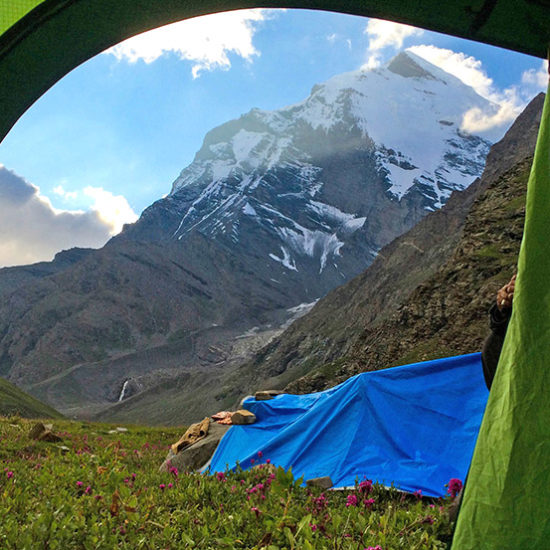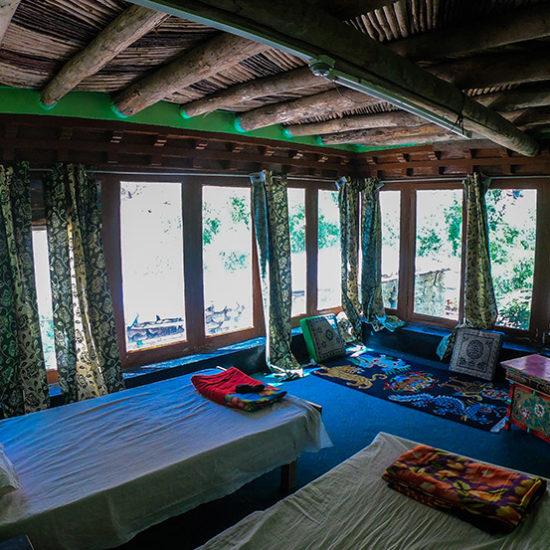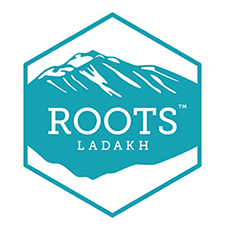Apricot Bloom
The apricot flower bloom signifies the onset of summer after the long and harsh winter of Ladakh. During this period, settlements in the western belt of Ladakh especially areas of Kargil are covered with a white sheet of flowers. It is probably the most beautiful time of the year but only lasts for about two weeks towards the end of April and beginning of May. Kargil boasts of the highest production of superior quality apricots across the Indian Himalayas.
This tour is a series of easy and scenic walks through the most beautiful apricot farming villages and will let you indulge in authentic rural experiences.
Perfect for couples or group friends who share the same love for the outdoors and are looking for an active holiday.
8 Nights / 9 Days Leh Download PDF
-
Tour StartsLeh
-
Tour EndsLeh
-
Style of TourVillage Walks, Jeep Tour
-
Max Altitude3100 m
-
Best SeasonMid April to Mid May
-
StaysHotels, Homestays, Organized Camping
-
MealsBreakfast and Dinner at Hotels, All Meals at Homestays
1
Day 1: Arrive in Leh and acclimatize
- Pick up from airport and transfer to hotel)
- Use this day to rest and acclimatize to the high altitude of Ladakh
- Staying hydrated and minimum exertion is key today to avoid Altitude Sickness
- You can take a stroll through the Leh Bazaar in the evening
- Dinner and overnight at the hotel
2
Day 2: Hemis monastery and Leh Old Town
- Today again we will take it easy and let the acclimatization process continue as we will be doing a lot of walking during the following days
- Start the day with a visit to the Hemis Gompa, the most iconic monastery of Ladakh which also holds the status of the wealthiest monastery of Ladakh. The sheer grandeur of the monastery is sure to keep you spell bound
- The journey is 40 kms one way covered in about and hour.
- Witness the copper gilded statue of Lord Buddha and a large statue of Guru Rimpoche is also quite interesting to witness
- The monastery also has a museum within its premises. Numerous historical and religious paintings (Thangkas), carriers, weapons are at display in the museum
- Return to Leh for lunch at a local eatery
- Post lunch you can take a walk through the Leh old town up to the Leh Palace to watch the sunset
- The walk is a unique window into Leh’s past as an important city on the Great Silk Route
- Alternatively, you can also choose to go café hopping in the town. We can suggest you some of our favourites
- Dinner and overnight at hotel/homestay
3
Day 3: Leh to Garkone via lower Indus - 167 kms (4 hours)
Trek Distance/Duration: 5 kms / 3 hours
- After an early breakfast today, we will drive towards Garkone village along the Indus river passing through a scenic landscape
- Enroute stop over at the Domkhar rock art site, a pre historic petroglyph site situated in a private apricot orchid. Take a guided tour with the local host. You can purchase authentic apricot oil and dried apricots from their family run farm.
- Garkone is one of the four villages in the Indus valley region inhabited by the “Brokpa” tribe
- Once at the village, the homestay is approached by a short walk.
- Meet and greet with the local host and sit down for lunch
- Relax and take in the beauty of this quaint village
4
Day 4: Garkone village walk and Local “Chhang” making
-
- Today we will start the day with part taking in “Chhang” preparation, a local beer made using barley
- Post this visit the local Labdak museum that preserves the Brokpa heritage of this valley. The museum itself is set up inside the 300 year old heritage building owned by your local host
- Take a walk through the apricot orchids in the village and explore the local culture. You will find locals elderly folk relishing the warm spring sun in their courtyards
- The warm climate of Garkone makes the land conducive for various other fruits which are not possible to grow in other parts of Ladakh such as walnut, pears, grapes and strawberries which you will discover as you walk through the village
- Lunch at homestay
- In the evening, you can enjoy the Chhang you helped prepare ealier and relax by a bonfire
5
Day 5: Garkone to Kargil via Humboting La (3900m) - 63 Kms (2 hours)
- Wake up at leisure and savor on some local breakfast
- Post breakfast, say goodbye to your local host and head towards Kargil via Humbtongi La pass
- Atop the pass offers breathtaking views of the mountains
- As you drive down towards Kargil take a short detour to discover a hidden relic. A 7th Century rock cut Maetriya Buddha statue in the village of Apati
- It is one of the three only remaining rock arts from the Pre-Tibetan period. A short but beautiful walk along a cobbled path through the village approaches the statue
- Spend some time here in contemplation
- Continue from here towards Kargil and check into your hotel
- Post lunch, take a walk to the Munshi Aziz Bhat Museum, a family run museum that showcases artifacts from the Silk Route trade heritage of Kargil. It is situated just above the town and provides great vistas of the town
- Kargil was once a thriving trade centre on the Silk Route. From the museum you can walk down to the old bazaar and explore the old shops
- The mighty Suru river flows cutting through the town of Kargil and makes for a nice riverside walk in the evening
- Dinner and overnight at the hotel
6
Day 6: Village Walks in Hardass and Hundurman village. Overnight at Hundurman border village
- After an early breakfast at the hotel we will set out to see the apricot blossom in Hardass village just off Kargil town
- Hardass is another unique settlement inhabited by the “Balti” tribe who are originally from Baltistan (now in Pakistan)
- Hardass is one of the highest producers of high quality “Halman” apricots so you can imagine how this village looks when the apricot flowers are in full bloom
- Take a casual stroll through the village and enjoy a cup of local “Namkeen Chai” in the orchids
- From here we will drive to Hundurman village which about 30 minutes from Hardass
- Hundurman is a frontier settlement near the Line of Control between India and Pakistan. The villagers now shifted to a new settlement near by, the original settlement is a 500 year old architectural marvel now in ruins. It has been transformed into a heritage experience called the Unlock Hundurman – Museum of Memories and houses personal object of people who used to live here. Once a village along the Silk Route, the settlement has a long war history and remained under Pakistani territory till 1971 post which there were many families that got separated. This museum is a window into Kargil’s unknown past.
- Continuing our exploration on foot, we will take a walk through this time capsule and eventually end up in the new settlement of Hundurman. A local host who will accompany us for the walk
- After a tour of the museum we will hike upstream through the village orchids
- In spring time, it is a beautiful green walk
- Explore the history and architecture of this forgotten village
- Learn how to make apricot oil
- Spend the night at the homestay.
7
Day 7: Suru valley drive and camping – 60 Kms one way (1.5 hours)
- Suru valley is probably the most underrated region of Ladakh in terms of scenic beauty. And if you have travelled this far, it would be a pity if you don’t experience Suru.
- Suru valley is an adventure paradise and the greenest region of Ladakh. Fed by numerous glacial streams, the Suru river snakes through the valley originating from the Zanskar mountain range with the Nun Kun massif as its crown jewel, two of Ladakh’s highest peaks standing at 7135m and 7070m respectively. In the spring time, Suru is covered by snow capped mountains and green hill sides with spectacular views of the Nun Kun Massif.
- After breakfast in Hundurman, drive towards Suru valley
- Have lunch in Sankoo
- It is a scenic drive along the Suru river
- The road bends to reveal the first sight of the Nun Kun massif in Purtiktsey. The massive white domes towering over the wide valley of Suru, is a spellbinding sight.
- Tonight we setup a private camp here with the best view of the valley
- Camping under the stars here with the a jaw dropping view of the Nun Kun range is surely the highlight of this trip
- Spend the evening by the bonfire and celebrate this moment with a beautiful sunset
8
Day 8: Suru to Leh via Namki La (3700m) and Foto La (4108m) – 260 Kms (6 hours)
- Wake up to catch the sunrise with a hot cup of tea
- Post breakfast, we will drive back to Leh via Namki La and Foto La pass along the NH1
- Spectacular panoramas from atop the passes as usual
- Enroute there are couple of worthwile historical sites to visit. You can check out the Shergole cave monastery, the Buddha rock statue in Mulbekh and Lamayuru monastery
- Arrive in Leh by evening and check into your hotel
- You can freshen up and rest after the long journey
- Dinner at overnight at the hotel
9
Day 9: Departure from Leh
- Early morning airport transfer
- INCLUSIONS
- EXCLUSIONS
- ADDITIONAL INFO
Transport:
- Airport transfers
- Vehicle throughout the journey
- All meals during stays
- Packed lunch for the road
- Twin sharing rooms at the hotels
- Twin sharing done tents during camping
- Quad sharing room at Hundurman
- Camping gear (sleeping bags, mattress, two man dome tents, toilet tent, dining tent)
- Safety gear (ropes, ice axe, micro spikes)
- Onsite first aid
- Oxygen cylinder
- Trained and experienced guide
- Inner Line Permit
Exclusions:
- Single room accommodation
- International & Domestic flight fares, visa charges
- Monument/monastery and Museum visit fee
- Any expenses of personal nature such as mineral water, laundry.
- Cost incurred due to emergency evacuation
- Any kind of insurance, such as accident, theft, medical, evacuation etc.
- Tips to porters, camping team, driver, guide, etc.
- Cost incurred due to change / extension in the itinerary due to roadblocks, bad weather condition, flight delays, vehicle breakdowns, etc.
Mountain Ethics
- We have a zero trash tolerance policy. We always clean up after ourselves on all hikes and trips
- We use portable T3 tents and portable toilets and wash basins at our campsite which are cleared and wrapped up at the end of each journey.
- Our camp locations are temporary and we don’t keep any permanent fixtures at the location. We say no to plastics
- Be Local – there is no harm learning at few local words while you are there. It always helps in building a rapport with the locals and blend in. Try to eat and buy locally. Carry your own water bottles.
- We use comfortable mattresses with -10degree sleeping bags
- There is no electricity at most of our campsites as they are at remote locations. We use solar powered tent lamps.
- Our trips require a moderate level of fitness.
- The maximum altitude for treks can go upto 6100m
- Drink lot of water to stay hydrated and to avoid mountain sickness
- We always carry a first aid kid and a portable oxygen canisters for emergencies
- Average of two guides are provided for a group of 10 people
- We respect the local traditions and customs. We will always brief you regarding these each time you travel to a different location. We encourage you to be open and free while travelling to these locations and invite you to explore the region in its true sense.
- We focus on engaging local communities in our work to create livelihoods locally. Most of our camps/homestays are managed by the local villagers and local youth is engaged as guides/hosts
- We organize workshops to train local communities and youth for technical training in mountain guiding, hospitality and responsible tourism. If you are interested in contributing, do let us know.
What to carry?
- Valid ID proof (Passport/Voter ID/Drivers Licence)
- Comfortable walking shoes
- A small daybag for walks
- One down jacket or warmer for chilly nights
- Rain poncho or jacket/windcheater (a must!)
- Sun block
- Hat
- Sun goggles
- Flashlight with extra batteries (preferably wearable)
- Water bottle, preferably wide mouthed, with at least one litre capacity
- Personal toiletries
- Power bank (if you want to use phone camera)
- That book you’ve been meaning to read
- Delays are expected on account of roadblock & weather conditions. Our effort will be to continue with the trip as per the schedule & make you as comfortable as possible. But in such situations we may have to compromise on the campsite & adjust to these situations then & there. The final call will be taken by our Lead Guide on location.
- The itinerary should be viewed as ideal & we may have to make some spot changes due various unavoidable reasons.
- The distances & altitude mentioned in the above itinerary are to the best of our knowledge & information; marginal variance in the actual distances & altitudes is possible.
- You are expected to be in reasonable shape and fitness, being able to walk for several hours at a normal pace as well as to take care of your own equipment.
- The minimum age restriction for this trip is 18
- All outdoor related activities involve a certain level of risk. You are expected to sign an Indemnity Form in agreement to the risks involved through part taking in such outdoor activities.
- Roots Ladakh reserves the right and permission to use photographs of individuals and photographs submitted by them on tour for use in promotional and publicity purposes













